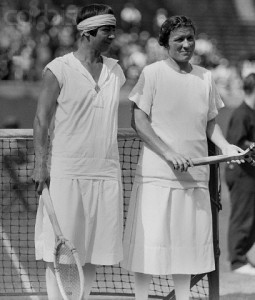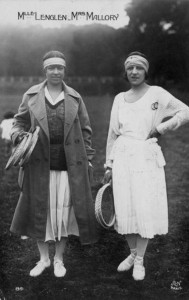Queens of the Court: Molla Mallory, Mould Breaker and Mould Maker

Molla Mallory won the U.S. Nationals women's singles title eight times, including four straight years from 1915-1918.
This is the first of a regular series of articles featuring some of the “Queens of the Court” in the history of women’s tennis.
When Anna Margarethe Bjurstedt was born in Oslo in March 1884, few could anticipate the mark she would make both on tennis and on women’s participation in sport.
This was the latter stages of the 19th century, when the modern rules of lawn tennis were still just 10 years old.
It was a world where Otto von Bismarck was Chancellor of Germany and Victoria was Queen of the British Empire.
There was no such thing as Greenwich Mean Time (that was set in October), and New York harbor was yet to receive the Statue of Liberty from France (on the 4th July that same year).
Van Gogh had not painted his “Sunflowers”, and Tchaikovsky had yet to write his “Sleeping Beauty.”
But this daughter of a Norwegian army officer was soon to introduce a new attitude and new approach to tennis.
In doing so, she won a record eight U.S. women’s singles titles and became the only woman—along with Chris Evert—to hold four of them consecutively. And her win in 1926, at the age of 42, established her as the oldest singles Grand Slam champion in history.
When Bjurstedt— Molla Mallory, as she was to become in 1919—first arrived in the United States in 1915, she had already won an Olympic bronze medal, but she was still a complete unknown. That was until she beat three-time defending champion Marie Wagner in straight sets to take the first of five singles titles at the national indoor championships.
That same year, she won the first of her eight Grand Slam titles.
What made Mallory stand out from the rest—and she beat a different woman in each of her eight Slam finals—was her attitude and her style of play.
It’s no surprise that she was regarded as a fierce competitor. Even at 42, in that 1926 match against Elizabeth Ryan, Mallory fought back from a 0-4 final set deficit to win the U.S. title 4-6, 6-4, 9-7.

Mallory (left) was 42-years-old when she rallied to defeat Elizabeth Ryan for the U.S. National Championship in 1926.
But she was also described as “running with limitless endurance,” and as using a powerful baseline game and strong forehand to run her opponents into the ground.
Bob Kelleher, a former president of the USTA, was a ball boy during Mallory’s era: “She looked and acted tough when she was on the court hitting tennis balls. She walked around in a manner that said you’d better look out or she’d deck you. She was an indomitable scrambler and runner. She was a fighter.”
It’s worth putting this into the context of her day. Mallory, along with her most renowned contemporary on the other side of the Atlantic, Suzanne Lenglen, entered a world of female competition where long skirts, long sleeves, and even boned corsets, were the order of the day.
But to play the kind of tennis that these new heroines of the game brought to the court needed change. Lenglen is credited with shocking European audiences—notably Wimbledon—with her calf-length, loose fitting attire, but Mallory was wearing exactly the same in the States.
This enabled her to play as she wanted rather than as women were expected.
One of her few recorded quotes shows the difference between the Mallory view and the more general style of the day:
“I find that the girls generally do not hit the ball as hard as they should. I believe in always hitting the ball with all my might, but there seems to be a disposition to ‘just get it over’ in many girls whom I have played. I do not call this tennis.”
It’s not difficult to extrapolate that same spirit to some of the most successful and inspirational women to play the game in our own era: Billie Jean King, Martina Navratilova, and the Williams sisters.

Suzanne Lenglen (right) was Mallory's greatest contemporary rival.
Though other modern-day champions such as Steffi Graf and Chris Evert may claim a greater inheritance from the elegant and balletic style of Mallory’s antithesis, Lenglen, they can also trace contemporary attitudes to fitness, speed and attack back to the Norwegian.
Mallory’s tennis career ended at 45, as a semi-finalist at her beloved Forest Hills. By that time, she had played in every U.S. Open between 1915 and 1929. Not content with winning eight of them, she was a finalist in two more, a semi-finalist in three and—her worst result—a quarter-finalist in 1927.
Mallory was also a fixture in the mixed doubles between 1915 and 1924, winning three times (twice with Bill Tilden), and being runner-up five times (again twice with Tilden). Add another pair of titles in the women’s doubles and Mallory boasts 13 American titles.
At this point, some historical context is again revealing.
The U.S. tournament was the only Grand Slam to continue through the First World War, and so Mallory did not make an assault on the European events until 1920.
By then, at 34 years of age, she could reasonably be considered to be past her physical peak, and so her success against a new generation of more liberated players was limited. She nevertheless reached one final, two semis, and two quarters at Wimbledon, and reached the final of the French at her first attempt, never having played on clay before.
It seems surprising, then, in the light of this woman’s extraordinary contribution to women’s tennis, that her name and achievements have not stood alongside those of her glamorous French counterpart.
Almost every reference to Lenglen ascribes to her a turning point in women’s tennis. She was undoubtedly one of the most gifted players of her era, and a beautiful and agile exponent of the game. She was also flamboyant, given to emotional tears, and had the glamour to draw French and British crowds in never-before-seen numbers.
However, she made just one visit to the U.S. Open, and exited in the second round. Her career ended in 1926.
In a reversal of their early fame, though, Mallory was inducted into the International Tennis Hall of Fame in 1958, one year before she died, aged 75, but a full 20 years before her more famous contemporary. Lenglen was not inducted until 1978, a full 40 years after her premature death.
And Mallory’s recognition has more recently had another boost. Just last year, her name took its place, along with that of Pete Sampras, in the Court of Champions at the Billie Jean King National Tennis Center.
At last, Mallory stands shoulder to shoulder with her equals: not only King, Navratilova, Evert, and Graf, but also Don Budge, Maureen Connolly, Margaret Court, Althea Gibson, Jack Kramer, Rod Laver, and Helen Wills.
And one more Champion who undoubtedly appreciated Mallory right from the first, from his own personal experience, is also there: former Grand Slam doubles partner, Bill Tilden.
Justice has been done.
Check back on October 28 as the next article in the “Queens of the Court” series will feature Helen Wills Moody.
Clarabella Bevis is a regular tennis contributor for Bleacher Report and has graciously allowed her work in the “Queens of the Court” series to appear on Sports Then and Now.
What pioneers!! This is way back — and to think those clothes once were called "revealing." LOL
I have included a fond portrait of the great Molla Mallory in my biography of her long-time doubles partner Eleonora Sears who won 2 national doubles titles with her, 2 with Hazel Wightman, and a mixed-doubles title with Willis Davis. Eleo Sears was the greatest pioneer of women's sports and the most vesatile female athlete on record. The book is " Prides Crossing: The Unbridled Life and Impatient Times of Eleonora Sears".
I would like to thank you for your efforts you’ve made in writing this post. I’m hoping the same best work from you also in the future as well. In fact your creative writing abilities have inspired me to begin my own BlogEngine blog now.
Hey there! Very useful article! I’m very delighted that I was able to stumble upon your blog whilst searching Google. Thank you for this excellent article!
wohh precisely what I was looking for, thanks for posting .
keep up the good work , I read few content on this site and I conceive that your website is very interesting and has circles of fantastic info .
I enjoy your work , regards for all the good blog posts.
I don’t ordinarily comment but I gotta tell regards for the post on this special one : D.
you are my inspiration , I own few web logs and occasionally run out from to brand : (.
you are my aspiration , I own few web logs and infrequently run out from to brand : (.
Utterly indited content material , appreciate it for selective information .
some times its a pain in the ass to read what people wrote but this internet site is very user pleasant! .
I always was concerned in this subject and still am, thanks for putting up.
I am thankful that I found this web site, just the right info that I was looking for! .
Simply wanna state that this is very helpful , Thanks for taking your time to write this.
keep up the wonderful piece of work, I read few posts on this web site and I believe that your website is really interesting and contains lots of excellent info .
I don’t usually comment but I gotta state thankyou for the post on this perfect one : D.
Rattling informative and great structure of written content , now that’s user friendly (:.
I was suggested this web site by means of my cousin. I’m not sure whether this publish is written through him as nobody else understand such special approximately my trouble. You’re amazing! Thanks!
I besides believe therefore , perfectly pent post! .
Searching over the number I may additionally point out header tags. It is important to try and use the keywords and phrases in the tag. It shows the search motors the expression is improtant and relevant. I may also try to fluctuate it a bit from the title tag.
Hey man , thanks 4 posting but this page doesnt format correctly in Chrome it is is overlapping.
Hello! Nice stuff, do inform me when you post something similar!
I got what you mean ,bookmarked , very decent web site .
Well accomplished. I love your posts.
“Saved as a favorite, I really like your blog!”
I conceive you have remarked some very interesting details , appreciate it for the post.
its great as your other posts : D, appreciate it for posting .
I conceive you have noted some very interesting details , appreciate it for the post.
some really prize content on this internet site , bookmarked .
some real good clause, you helped my animals so much thanks .
I’m still learning from you, but I’m improving myself. I absolutely liked reading everything that is posted on your website.Keep the stories coming. I enjoyed it!